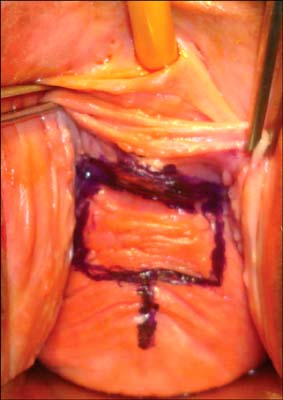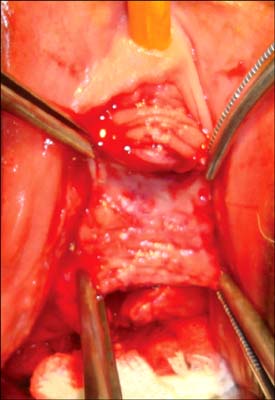Korean J Urol.
2011 Mar;52(3):184-188.
How to Achieve Long-Term Success in the Treatment of Female Urinary Stress Incontinence? Novel Modification on Vaginal Sling
- Affiliations
-
- 1Department of Urology, Osmaniye State Hospital, Osmaniye, Turkey. dr_mahmoud68@yahoo.com
Abstract
- PURPOSE
Modest long-term success is one of the most disappointing issues facing patients undergoing anti-incontinence surgery. Herein we introduce a novel surgical modification of the vaginal sling to address the mechanisms that may lead to a reduction in the success rate at the long-term follow-up.
MATERIALS AND METHODS
Twenty-three female patients with mean age of 48.2 years (range, 22-73 years) underwent anti-incontinence surgery to correct their stress urinary incontinence (SUI) between August 2006 and January 2008. The in situ anterior vaginal wall sling, reinforced with equi-size monofilament polypropylene tape, was used as an anti-incontinence surgical procedure. The mean follow-up period was 30.2 months (range, 24-38 months).
RESULTS
The surgical technique was successful in 22 patients (95.65%); 20 of them were cured and 2 patients showed clinical improvements. Urinary retention was observed in one patient (4.34%), which was resolved after decreasing the tension of the suspension sutures. No significant post-voiding residue was detected postoperatively.
CONCLUSIONS
Cost-effectiveness and a low risk of urethral erosion, due to the presence of intervening vaginal mucosa, are important advantages of this technique. Long-term success is expected, because relaxation of the non-tension-free suspension sutures and dislocation of the midurethral sling are less likely.
MeSH Terms
Figure
Reference
-
1. Elving LB, Foldspang A, Lam GW, Mommsen S. Descriptive epidemiology of urinary incontinence in 3,100 women age 30-59. Scand J Urol Nephrol Suppl. 1989. 125:37–43.2. Diokno AC, Brock BM, Brown MB, Herzog AR. Prevalence of urinary incontinence and other urological symptoms in the noninstitutionalized elderly. J Urol. 1986. 136:1022–1025.3. Nygaard IE, Heit M. Stress urinary incontinence. Obstet Gynecol. 2004. 104:607–620.4. Liapis A, Bakas P, Creatsas G. Burch colposuspension and tension-free vaginal tape in the management of stress urinary incontinence in women. Eur Urol. 2002. 41:469–473.5. Ulmsten U, Henriksson L, Johnson P, Varhos G. An ambulatory surgical procedure under local anesthesia for treatment of female urinary incontinence. Int Urogynecol J Pelvic Floor Dysfunct. 1996. 7:81–85.6. Blaivas JG. Kursh ED, McGuire EJ, editors. Pubovaginal slings. Female urology. 1994. Philadelphia: JB Lippincott;235.7. Wright EJ, Iselin CE, Carr LK, Webster GD. Pubovaginal sling using cadaveric allograft fascia for the treatment of intrinsic sphincter deficiency. J Urol. 1998. 160:759–762.8. Wilson TS, Lemack GE. Carlin Bl, Leong FC, editors. Transvaginal surgery for stress urinary incontinence. Female pelvic health and reconstructive surgery. 2003. New York: Marcel Dekker;137.9. Leach GE, Dmochowski RR, Appell RA, Blaivas JG, Hadley HR, Luber KM, et al. Female Stress Urinary Incontinence Clinical Guidelines Panel summary report on surgical management of female stress urinary incontinence. The American Urological Association. J Urol. 1997. 158:875–880.10. Ulmsten U, Johnson P, Rezapour M. A three-year follow up of tension free vaginal tape for surgical treatment of female stress urinary incontinence. Br J Obstet Gynaecol. 1999. 106:345–350.11. Nilsson CG, Falconer C, Rezapour M. Seven-year follow-up of the tension-free vaginal tape procedure for treatment of urinary incontinence. Obstet Gynecol. 2004. 104:1259–1262.12. Doo CK, Hong B, Chung BJ, Kim JY, Jung HC, Lee KS, et al. Five-year outcomes of the tension-free vaginal tape procedure for treatment of female stress urinary incontinence. Eur Urol. 2006. 50:333–338.13. Lo TS, Horng SG, Liang CC, Lee SJ, Soong YK. Ultrasound assessment of mid-urethra tape at three-year follow-up after tension-free vaginal tape procedure. Urology. 2004. 63:671–675.14. Poon C, Zimmern P. When the sling is too proximal: a specific mechanism of persistent stress incontinence after pubovaginal sling placement. Urology. 2004. 64:287–291.15. Lo TS, Lee SJ. Treatment of recurrent genuine stress incontinence by shortening previously implanted tension-free vaginal tape. Acta Obstet Gynecol Scand. 2004. 83:1005–1006.16. Zorn KC, Spiess PE, Singh G, Orvieto MA, Moore B, Corcos J. Long-term tensile properties of tension-free vaginal tape, suprapubic arc sling system and urethral sling in an in vivo rat model. J Urol. 2007. 177:1195–1198.17. Baden WF, Walker TA. Statistical evaluation of vaginal relaxation. Clin Obstet Gynecol. 1972. 15:1070–1072.18. Ward KL, Hilton P. A prospective multicenter randomized trial of tension-free vaginal tape and colposuspension for primary urodynamic stress incontinence: two-year follow-up. Am J Obstet Gynecol. 2004. 190:324–331.19. Neuman M. Infected hematoma following tension-free vaginal tape implantation. J Urol. 2002. 168:2549.20. Neuman M. Tension free vaginal tape bladder penetration and long lasting transvesical prolene material. J Pelvic Med Surg. 2004. 10:307–309.21. de Leval J. Novel surgical technique for the treatment of female stress urinary incontinence: transobturator vaginal tape inside-out. Eur Urol. 2003. 44:724–730.22. Neuman M. TVT and TVT-obturator: comparison of two operative procedures. Eur J Obstet Gynecol Reprod Biol. 2007. 131:89–92.23. Neuman M. TVT-obturator: short-term data on an operative procedure for the cure of female stress urinary incontinence performed on 300 patients. Eur Urol. 2007. 51:1083–1087.24. Kuuva N, Nilsson CG. A nationwide analysis of complications associated with the tension-free vaginal tape (TVT) procedure. Acta Obstet Gynecol Scand. 2002. 81:72–77.25. Abdel-Fattah M, Barrington JW, Arunkalaivanan AS. Pelvicol pubovaginal sling versus tension-free vaginal tape for treatment of urodynamic stress incontinence: a prospective randomized three-year follow-up study. Eur Urol. 2004. 46:629–635.26. Mustafa M, Wadie BS. Placard-shaped in situ vaginal wall sling for the treatment of stress urinary incontinence. Int J Urol. 2006. 13:132–134.27. Mustafa MO, Wadie BS. Novel technique for the treatment of stress urinary incontinence. Early experience. Saudi Med J. 2009. 30:234–237.28. Lee JH, Cho MC, Oh SJ, Kim SW, Paick JS. Long-term outcome of the tension-free vaginal tape procedure in female urinary incontinence: a 6-year follow-up. Korean J Urol. 2010. 51:409–415.29. Lo TS, Wang AC, Liang CC, Long CY, Lee SJ. Treatment for unsuccessful tension-free vaginal tape operation by shortening pre-implanted tape. J Urol. 2006. 175:2196–2199.30. Merlin T, Arnold E, Petros P, MacTaggart P, Tulloch A, Faulkner K, et al. A systematic review of tension-free urethropexy for stress urinary incontinence: intravaginal slingplasty and the tension-free vaginal tape procedures. BJU Int. 2001. 88:871–880.
- Full Text Links
- Actions
-
Cited
- CITED
-
- Close
- Share
- Similar articles
-
- Comparison of Using Anterior Vaginal Wall and Cadaveric Fascia Lata in Sling Operation for the Management of Female Stress Urinary Incontinence
- The Experience After Operation Using Tension-free Vaginal Tape for Stress Urinary Incontinence
- Anterior Vaginal Wall Sling for Female Stress Urinary Incontinence
- Comparison of Vaginal Wall Sling and Pubovaginal Fascial Sling in Management of Genunine Stress Urinary Incontinence
- Result and Factors Contributing to Patients' Satisfaction of Anterior Vaginal Wall Sling Operation




